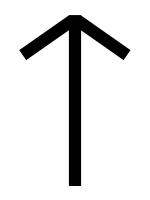Tiwaz
Tiwaz ( ᛏ , also Tyr rune) is the seventeenth of the 24 runes of the older Germanic runic alphabet Futhark and the twelfth of the 16 of the younger Futhark. Their phonetic value is T .
Explanation
The rune is assigned to the sky and war god Tyr ( ahd. Ziu , Zio ).
In the old Norwegian rune poem , the name is interpreted in the memory verse alluding to the Nordic myth: Týr er æinendr ása - Tyr er is the one-handed god . According to the song Sigrdrífumál from the so-called older Edda , the song Edda, the Tyr rune should be carved twice into the sword in order to achieve victory.
Sigrúnar þú scalt kunna, ef þú vilt sigr hafa,
oc rísta á hialti hiors,
sumar á véttrimom, sumar á valbǫstom,
oc nefna tysvar Tý.
Siegrunen cut when you want victory;
Dig them on the hilt of the sword;
Some on the sides, others on the guard
and name Tyr twice.
In the Salzburg-Vienna manuscript , the rune is referred to as Tys = Ziu in a Gothic rune alphabet traced back to Alcuin as a scribe, next to an Old English Futhorc .
In the old English rune poem from 10/11. Century is the rune, alteng. Tīw , transliterated as Tīr through Nordic influence . From the poetic overwriting (interpolation) by the learned poet on the assumption that Tīr refers to the constellation of the bull Taurus , the author gave the rune a meaning as a sign (miraculous sign, ancient tacna ) in the figurative sense as a star.
Tir biþ tacna sum, healdeð trywa wel
wiþ æþelingas; a biþ on færylde
ofer nihta genipu, næfre swiceþ.
Tiw is a guiding star, he keeps his loyalty to
the prince well; he is always on his way
over the mists of night and never fails.
In the bracteate Seeland-II-C , the Tiwaz rune was coined three times in order to reinforce the cultic meaning.
Character encoding
| Unicode codepoint | U + 16CF |
| Unicode name | RUNIC LETTER TIWAZ TIR TYR T |
| HTML | & # 5839 |
| character | ᛏ |
literature
- Klaus Düwel: Runic lore . 3rd expanded edition. Metzler, Stuttgart 2001, ISBN 3-476-13072-X .
Remarks
- ^ Norbert Wagner : To the Gotica of the Salzburg-Vienna Alcuin manuscript. In: Historische Sprachforschung 107 (1994), pp. 262-283.
